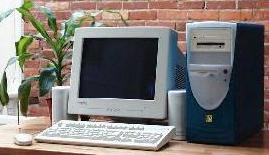

 |
 |

The real question is, what's the very best thing about this computer? It's turquoise. Actually, the particular machine NexTrend sent to our product testing lab has a Pentium III 500MHz CPU, an 8.4GB drive and 128MB of RAM, which are also nice. To be honest, this machine is actually quite loaded. Still, if you order one, you can have more or less any configuration, as far as I know. The true question, aside from the color, is how well the Linux system operates.
It looks like a Macintosh, but we all knew that about turquoise-colored machines running KDE. Still, what with the color of the machine (perhaps more accurately described as teal), it feels particularly inviting, on top of which Caldera OpenLinux 2.2 is a tight, clean distribution which includes a lot of productivity software preconfigured into the menuing system (such as Netscape, WordPerfect 8.0 and Star Office 5). COAS (Caldera Open Administration System) is a small, fast program for dealing with things ranging from system administration to machine-specific hardware configuration, and even includes a loader for kernel modules. Taken on the whole, Caldera OpenLinux 2.2 fits very nicely on the home desktop computer, and while it is known as ``Linux for Business'', the important point is it works, is easy to use and comes with a lot of software, though still no pico.
Although Caldera has about the easiest installer going, one way around the alleged difficulty of Linux installation is to buy a pre-installed system. The NexStar system is completely configured, with an optimal kernel and dozens of modules. Everything works on this machine, from the XF86Config file, to the Sound Blaster 64AWE card, the 56K modem, the Intel 8460B Ethernet card, the 48X speed CD-ROM drive, the Iomega ZIP drive (though this is not pre-configured into fstab), the floppy drive, the 8.4GB hard drive (okay, if this didn't work, there'd be a problem), the ATI AGP 8MB video card, etc. XF86Config is ideally configured for the optional CyberVision monitor in both 800x600 (84Hz) and 1024x768 (70Hz) modes (I added a nice 1152x864 mode at 69Hz), though libvga.config is not configured (just copy data from XF86Config). The video timings are more or less perfectly matched to the monitor, and when the system is up and running, it's quite neat. However, it is possible to make a mess of things.
The one annoyance in OpenLinux 2.2 is that once you have ``shutdown'' KDE to console mode, you cannot get it up again. startx and kde just start up a bare X screen and the client has authority issues connecting to the server, so all you get to do is move an X over a test pattern. Typing telinit 5 won't solve this problem, but you can reboot or else just remember not to shut down KDE. The remedy, an update of XFree86, is available on Caldera's web site. OpenLinux 2.2 has the feel one expects of a professional Linux system, and COAS is truly neat. While hackers often like Slackware, and SuSE, Debian GNU/Linux, and the ubiquitous Red Hat are also superb choices, Caldera OpenLinux 2.2 is ideal for the user who wants a pre-installed system--it has a lot of software organized neatly into KDE's menus, is a complete system and truly feels like one. NexTrend's selection of OpenLinux is a point to consider when deciding which Linux PC maker to choose, if for example you're bored with Red Hat.
No computer review is complete without some benchmarks, but we haven't finished our custom benchmark software, so it's time for benchmark trivia. The cat /proc/cpuinfo command reports 498.07 bogomips; the Crafty chess engine evaluates about 190,000 positions per second; bonnie reports block writing at 21533KB/sec and block input at 14684KB/sec, and BYTEmark evaluates the system to have a memory index of 2.082, an integer index of 1.794, and a floating-point index of 4.603 (compared to AMDK6/233). It took 3.5 minutes to make bzImage for a 462KB kernel.
Many machines are out there, so be sure to shop around, and if you order from NexTrend, make sure they still put Linux boxes in these cool, teal shells.

Jason Kroll is your amiable Technical Editor who frequently reviews hardware and software, and is rumored to have interests outside of computers. He can be reached at hyena@ssc.com.